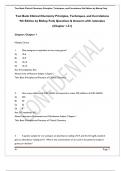Test Bank Clinical Chemistry Principles, Techniques, and Correlations 9th Edition by Bishop Fody
Test Bank Clinical Chemistry Principles, Techniques, and Correlations
9th Edition by Bishop Fody Questions & Answers with rationales
(Chapter 1-31)
Chapter: Chapter 1
Multiple Choice
1. One nanogram is equivalent to how many grams?
A) 10-6
B) 10-9
C) 10-12
D) 10-15
Ans: B Complexity: RL2
Ahead: Units of Measure Subject: Chapter 1
Title: Basic Principles and Practices of Clinical Chemistry
2. How many milliliters of 0.5N NaOH are required to make 100 milliliters of 0.2N NaOH?
A) 250
B) 40
C) 25
D) 4
Ans: B Complexity: RL2
Ahead: Laboratory Mathematics and Calculations Subject: Chapter 1
Title: Basic Principles and Practices of Clinical Chemistry
3. A patient sample for uric acid gave an absorbance reading of 0.4, and the 50 mg/dL standard
gave an absorbance reading of 0.1. What is the concentration of uric acid in the patient's sample in
grams per deciliter?
A+ Page 1
,Test Bank Clinical Chemistry Principles, Techniques, and Correlations 9th Edition by Bishop Fody
A) 0.2
B) 12.5
C) 125
D) 200
Ans: D Complexity: RL2
Ahead: Laboratory Mathematics and Calculations
Subject: Chapter 1
Title: Basic Principles and Practices of Clinical Chemistry
4. How many millimoles of NaCl are contained in 300 mL of a 4M solution? (gmw = 58.5)
A) 70
B) 120
C) 234
D) 1200
Ans: D Complexity: RL2
Ahead: Laboratory Mathematics and Calculations Subject: Chapter 1
Title: Basic Principles and Practices of Clinical Chemistry
5. How is 10 mg/dL of calcium reported in mmol/L? (gmw = 40)
A) 2.5
B) 5.0
C) 10
D) 25
Ans: A Complexity: RL2
Ahead: Laboratory Mathematics and Calculations Subject: Chapter 1
Title: Basic Principles and Practices of Clinical Chemistry
A+ Page 2
,Test Bank Clinical Chemistry Principles, Techniques, and Correlations 9th Edition by Bishop Fody
6. How many milliliters of concentrated sulfuric acid (H2S04), G.M.W. = 98 grams, specific gravity
= 1.500, purity = 80%, are needed to make 400 mL of a 2N solution?
A) 26.1
B) 32.7
C) 52.3
D) 65.3
Ans: B Complexity: RL2
Ahead: Laboratory Mathematics and Calculations Subject: Chapter 1
Title: Basic Principles and Practices of Clinical Chemistry
7. How many grams of hydrated MgSO4 5 H20 (M.W.: MgSO4 = 119, H20 = 18) are required
to make a 10% solution of MgS04?
A) 5.7 g/dL
B) 11.9 g/dL
C) 17.6 g/dL
D) 20.9 g/dL Ans: C Complexity: RL2
Ahead: Laboratory Mathematics and Calculations Subject: Chapter 1
Title: Basic Principles and Practices of Clinical Chemistry
8. What is the molarity (M) of a 4% solution of sodium hydroxide (NaOH)? M.W: Na = 23, O =
16, H = 1.
A) 0.1M
B) 0.25M
C) 1.0M
D) 2.5M
Ans: C Complexity: RL2
Ahead: Laboratory Mathematics and Calculations Subject: Chapter 1
Title: Basic Principles and Practices of Clinical Chemistry
A+ Page 3
, Test Bank Clinical Chemistry Principles, Techniques, and Correlations 9th Edition by Bishop Fody
9. 3 mg/dL is equivalent to how many grams per liter?
A) 0.003
B) 0.03
C) 0.3
D) 3
Ans: B Complexity: RL2
Ahead: Units of Measure Subject: Chapter 1
Title: Basic Principles and Practices of Clinical Chemistry
10. What is the normality of a solution containing 4.5 grams of BaCl2 in 400 mL? (gmw = 208)
A) 1.10
B) 0.50
C) 0.25
D) 0.11
Ans: D Complexity: RL2
Ahead: Laboratory Mathematics and Calculations Subject: Chapter 1
Title: Basic Principles and Practices of Clinical Chemistry
11. What are the optimal conditions for specimen transport, handling, and storage of specimens for
clinical chemistry testing?
A) Specimen transported to lab within 2 hours after collection, stored at room temperature, and
centrifuged within 4 hours.
B) Specimen transported to lab immediately, permitted to clot, serum separated and tested as soon
as possible.
C) Specimen brought to lab immediately, spun down, and serum left to stand on clot until tested.
D) None of these represent optimal conditions. Ans: B
Complexity: RL1
Ahead: Specimen Collection and Handling Subject: Chapter 1
Title: Basic Principles and Practices of Clinical Chemistry
A+ Page 4




